Full Text Searchable PDF User Manual

DMAN-xxxx-xx (Rev x.x)
www.omnexcontrols.com
call toll free: 1-800-663-8806
GENERIC 6SW
Installation / Configuration Manual
T150 Transmitter
R130 Receiver
#74-1833 Coast Meridian Road, Port Coquitlam, BC, Canada • V3C 6G5
Ph# (604) 944-9247 • Fax# (604) 944-9267
Toll Free 1-800-663-8806
Revised May 23, 2006
Version 2
DMAN - xxxx - xx

2
DMAN-xxxx-xx (Rev x.x)
www.omnexcontrols.com
call toll free: 1-800-663-8806
System Overview ........................................................................................................................................ 3
Features ....................................................................................................................................................... 3
T150 Dimensions and Controls.................................................................................................................... 3
Installing the Receiver.................................................................................................................................. 4
Anti 2 Block Wiring ....................................................................................................................................... 5
Installation Considerations ........................................................................................................................... 5
Power the Transmitter.................................................................................................................................. 6
Test the Transmitter / Receiver Link ............................................................................................................ 6
Download ID Code ....................................................................................................................................... 7
Calibrating Proportional Controls ................................................................................................................. 9
Diagnostics—T150 Transmitter.................................................................................................................... 10
Diagnostics—R130 Receiver ....................................................................................................................... 11
Troubleshooting Guide................................................................................................................................. 12
Parts & Accessories ..................................................................................................................................... 16
Specifications ............................................................................................................................................... 16
Warranty Information.................................................................................................................................... 16
NOTE: These instructions are intended only for installing and operating the remote control equipment described here. This is not a
complete Operator’s Manual. For complete operating instructions, please read the Operator’s Manual appropriate for your particular
machine.
READ ALL INSTRUCTIONS
CAUTION:
Changes or modifications not expressly approved by the party responsible for compliance could void the
user's authority to operate the equipment.
Failure to follow the SAFETY PRECAUTIONS may result in radio equipment failure and serious personal injury
Installation
PROVIDE A SAFETY CUTOFF SWITCH. If maintenance is required, the radio must be disconnected from power
USE PROPER WIRING. Loose or frayed wires can cause system failure, intermittent operation, machine damage, etc.
DO NOT INSTALL IN HOT AREAS. This apparatus can be damaged by heat in excess of 158° F (70° C)
Personal Safety
MAKE SURE MACHINERY AND SURROUNDING AREA IS CLEAR BEFORE OPERATING. Do not activate the re-
mote system unless it is safe to do so.
TURN OFF THE RECEIVER POWER BEFORE WORKING ON MACHINERY. Always disconnect the remote system
before doing any maintenance to prevent accidental operation of the machine
Care
KEEP DRY. Do not clean the transmitter / receiver under high pressure. If water or other liquids get inside the transmit-
ter battery or receiver compartment, immediately dry the unit. Remove the case and let the unit air dry
CLEAN THE UNIT AFTER OPERATION. Remove any mud, dirt, concrete, etc. from the unit to prevent clogging of but-
tons, switches, etc. by using a damp cloth.
Maintenance / Welding
DISCONNECT THE RADIO RECEIVER BEFORE WELDING on the machine the receiver is connected to. Failure to
disconnect will result in the destruction of the radio receiver.
Table of Contents
Safety Precautions
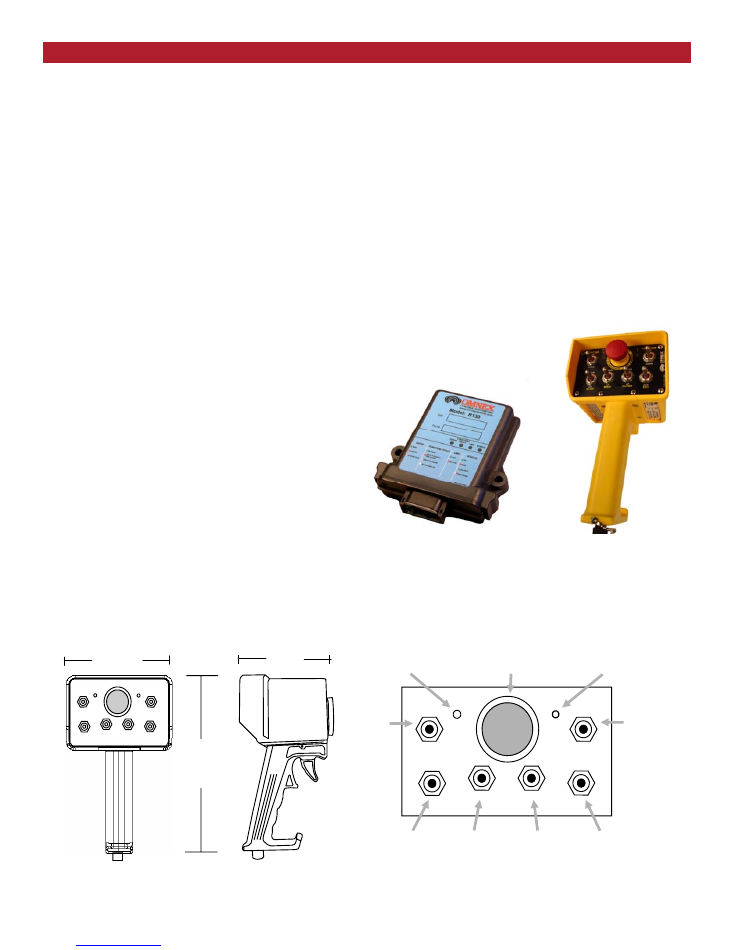
3
DMAN-xxxx-xx (Rev x.x)
www.omnexcontrols.com
call toll free: 1-800-663-8806
The
ORIGA
T150 / R130
is a portable, long range, programmable radio remote control system. Designed as a compact
and easy-to-use product, this member of the
ORIGA
family puts complete control of your crane where it’s needed most,
with the operator. It’s robust, easy to install and has complete self-diagnostics. This system can be a simple cable re-
placement or add intelligence to make it a total crane control package. It’s a radio, a PLC and a valve driver all in one.
The
ORIGA
T150 / R130
system uses Frequency Hopping Spread Spectrum (FHSS) technology. FHSS devices con-
centrate their full power into a very narrow signal that randomly hops from frequency to frequency within a designated
band. This transmission pattern, along with CRC-16 error-checking techniques, enables signals to overcome interfer-
ence that commonly affects licensed radios.
The R130 receiver
is designed to be powered from a 12VDC or 24VDC system. It features 4 solid state, high-side driver
input / output controls and a reliable E-Stop control.
The T150 transmitter
comes with 4 to 6 switches and an optional proportional trigger control. It uses standard, long
lasting AA batteries. Each T150 transmitter uses a unique ID code to ensure that no two systems will conflict at a job
site.
Features
•
FCC, ISC, CE approved
•
License free
•
1200 foot range @ 900 MHz (900 ft. @ 2.4 GHz)
•
Hand held / weatherproof / ergonomic
•
Simple “wire-and-use” installation
•
Resilient to impact and shock
•
Available in both 900 MHz and 2.4 GHz
•
Available with optional trigger for proportional control
•
Available with E-Stop for ensured operator safety
•
Available with an optional tether cable
•
Factory configurable for all custom applications.
Battery Low LED
Active LED
E-Stop Button
SW - 5
SW - 6
SW - 1
SW - 2
SW - 3
SW - 4
T150 Dimensions and Controls
System Overview
7.87”
4.13”
4.92”
R130 Receiver
T150 Transmitter
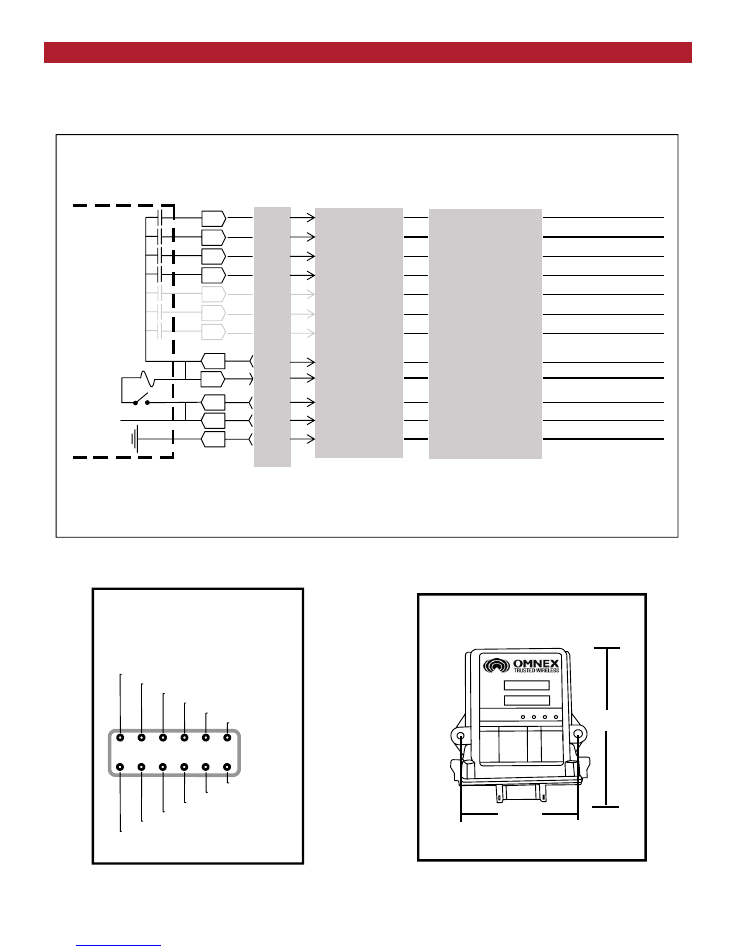
4
DMAN-xxxx-xx (Rev x.x)
www.omnexcontrols.com
call toll free: 1-800-663-8806
Installing the Receiver
Connector Pin
Assignments
Connectors as seen from under the receiver
R130 Dimensions
4.00”
5.13”
Drive Power Input
N/A
6 5 4 3 2 1
7 8 9 10 11 12
Output 4
Output 3
Output 2
Output 1
E-Stop Output
E-Stop In
N/A
Power
Ground
N/A
Use the
Wiring Diagram
and below to connect the receiver pins directly to the appropriate contacts of the machine
electronics. R130 Output Cables can be provided with every system to simplify the wiring process. The Wire # column
below only applies to the OMNEX Output Cable configuration. Tips on mounting, power connections and filtering are
also provided under
Installation Considerations
.
Wiring Diagram
The receiver is internally fused as shown using a 10A MINI® fuse. Follow the steps in transmitter / receiver replacement to
open the receiver for fuse replacement.
Receiver Relay
Outputs (Pins)
Receiver
Internal
Internally fused
E-Stop
A7
A8
A9
A10
A2
A5
A1
A12
A11
A6
A4
A3
1
2
3
4
5
5
6
6
Green/
Yellow
Output 1
Output 2
Output 3
Output 4
N/A
N/A
N/A
Drive Power Input
(May be jumpered externally)
E-Stop Out
E-Stop IN
Power
Ground
Wire #
Solid State FET 3A Max.
Solid State FET 3A Max.
Solid State FET 3A Max.
Solid State FET 3A Max.
N/A
N/A
N/A
10A
4A
4A
+9 to 30V DC
Ground
Function Notes
Attribute
Outputs—4 X Solid State, monitored, 3A max. each, total combined current 10A.

5
DMAN-xxxx-xx (Rev x.x)
www.omnexcontrols.com
call toll free: 1-800-663-8806
Mounting and Installation
The receiver can be mounted by fastening two ¼” bolts through the two mounting holes in the unit’s enclosure. When
mounting, ensure that the receiver is oriented so that the text is reading right and the connectors pointing “down”.
When selecting a mounting point for the receiver, it is recommended that the location require only a minimal
length of wiring to connect it to the control panel, that it will be in a visible area where it has good exposure to
the operator and that it is mounted on a surface that is protected from the weather and sustains minimal vibra-
tion. It is also recommended that the receiver have the best possible line of sight with the transmitter
Power Connections and Wiring
Whenever a power connection is made to an electronic device, it is a good practice to make both the Power (+) and
Ground (-) connections directly to the Battery and avoid connecting the power from the charging side of existing wiring or
making use of existing "ACC" or other peripheral connection points.
Make sure that wire of sufficient gauge and insulator type is used when connecting the outputs of the receiver to the con-
trol panel. Observe any component manufacturer's instructions and recommendations for proper integration of their
product. This includes the power ratings and requirements of such components as relays, valves, solenoids, etc.
Be sure to test each of the outputs with a multi-meter prior to connecting the outputs to your end devices. This will ensure
that each output has been programmed to operate in the manner required by each end device.
Filtering and Noise Suppression
Whenever a solenoid or electromagnetic switch is controlled by the receiver, it is a good practice to install a Diode across
its terminals to ensure that surges and spikes do not continue back into the circuit. Appropriate 36V Bi-directional Diodes
kits can be ordered under the OMNEX part number “AKIT-2492-01”.
Special Functions
Installation Considerations
NOTE:
The FCC and ISC require that the antenna be restricted to that supplied by the manufacturer and approved for use with this product. An op-
tional 0dB coax wire antenna may be supplied. For other antenna options, please contact OMNEX Control Systems ULC
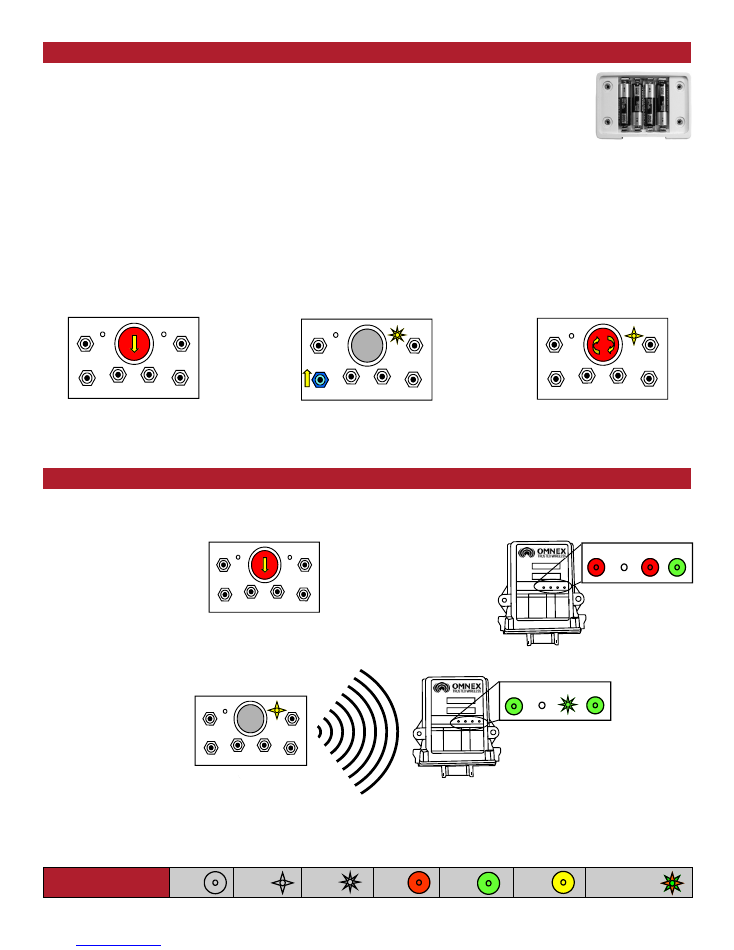
6
DMAN-xxxx-xx (Rev x.x)
www.omnexcontrols.com
call toll free: 1-800-663-8806
When the receiver has been installed, install batteries into the transmitter and turn it on as ex-
plained below.
1. Install Batteries
Remove the battery cover on the back of the transmitter using a slotted screwdriver and insert 4 "AA"
alkaline batteries. Orientation of the batteries is embossed inside the battery housing. No batteries
are required when the transmitter is connected to the receiver by a Tether Cable.
NOTE:
For operation at temperatures below –10° C lithium batteries are recommended. Low temperatures reduce battery
performance for both alkaline and lithium types. Refer to the battery manufacturer’s specifications for detailed information on
low temperature performance.
2. Turn on the Transmitter
Refer to the
Light Legend
below for diagram details.
T150 Battery
Housing
If the transmitter's (Active) light does not flash, check the battery orientation.
To turn off the transmitter, press the [E-Stop] button.
Follow these steps to ensure that there is a radio link between the transmitter and receiver.
Refer to the
Light Legend
below for diagram details
If the receiver's (Link) light does not flash GREEN, follow the steps under
Download ID Code
below.
The ORIGA system is now ready for use.
1. Press [E-Stop]
1. Press [E-Stop]
2. Power the R130
3. Power the T150
If the (Active) light on the trans-
mitter is flashing and the (Link)
light on the receiver is flashing
GREEN, a link between the two
exists.
2. Press any switch
3. Twist Clockwise & Release [E-Stop]
Power the Transmitter
Test the Transmitter / Receiver Link
Light Legend
Solid
Slow
Flash
Fast
Flash
Red
Light
Green
Light
Alternating Red
& Green Light
Yellow
Light
WARNING:
do not install batteries backwards, charge, put in fire,
or mix with other battery types. May explode or leak causing in-
jury.
Replace all batteries at the same time as a complete set
and do not mix and match battery types.
ESTOP FAULT LINK STATUS
ESTOP FAULT LINK STATUS
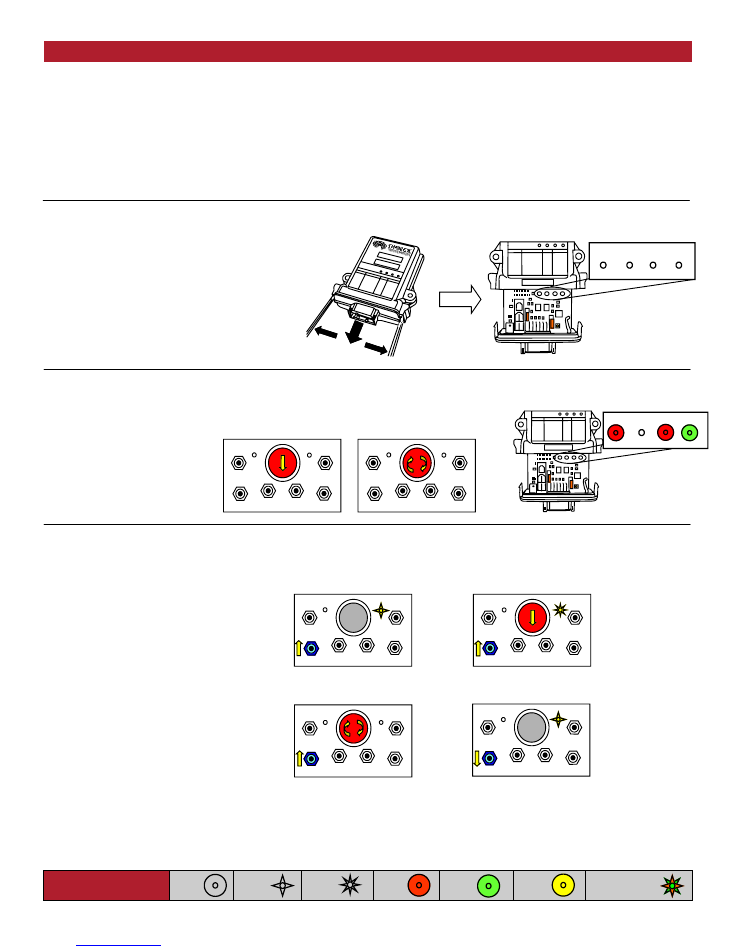
7
DMAN-xxxx-xx (Rev x.x)
www.omnexcontrols.com
call toll free: 1-800-663-8806
Follow these steps to download the transmitter’s unique ID Code into the receiver. This will allow the receiver to establish
a radio link with that transmitter.
Refer to the
Light Legend
below for diagram details. Refer to
Troubleshooting Chart #4
for Tips and Considerations
NOTE: It is necessary to download the ID Code when replacing either the transmitter or the receiver.
NOTE: If the transmitter is connected to the receiver with a Tether Cable, completing only steps 3 and 5 is necessary (it is not
necessary to open the R130 case and press the Setup button).
The cap is held on by two plastic tabs at
opposing sides, which can be unlatched as
shown using a screwdriver. Once the cap is
free, the R130 can slide open.
Use a small slotted screwdriver to press the
Side Tabs inward.
1. Opening the R130 Case
A. Press [E-Stop]
B. Twist clockwise & release [E-
Stop]
C. Supply power to the receiver
A. B.
2. Prepare T150, Power R130
A. Hold [SW-5] switch UP
B. Press [E-Stop]
C. Twist clockwise & release [E-Stop]
D. Release [SW-5] Switch
3. Power T150 into Configuration Mode
A.
D.
Download ID Code
(Use in case of Link Test failure)
Light Legend
Solid
Slow
Flash
Fast
Flash
Red
Light
Green
Light
Alternating Red
& Green Light
Yellow
Light
B.
C.
ESTOP FAULT LINK STATUS
ESTOP FAULT LINK STATUS
C.
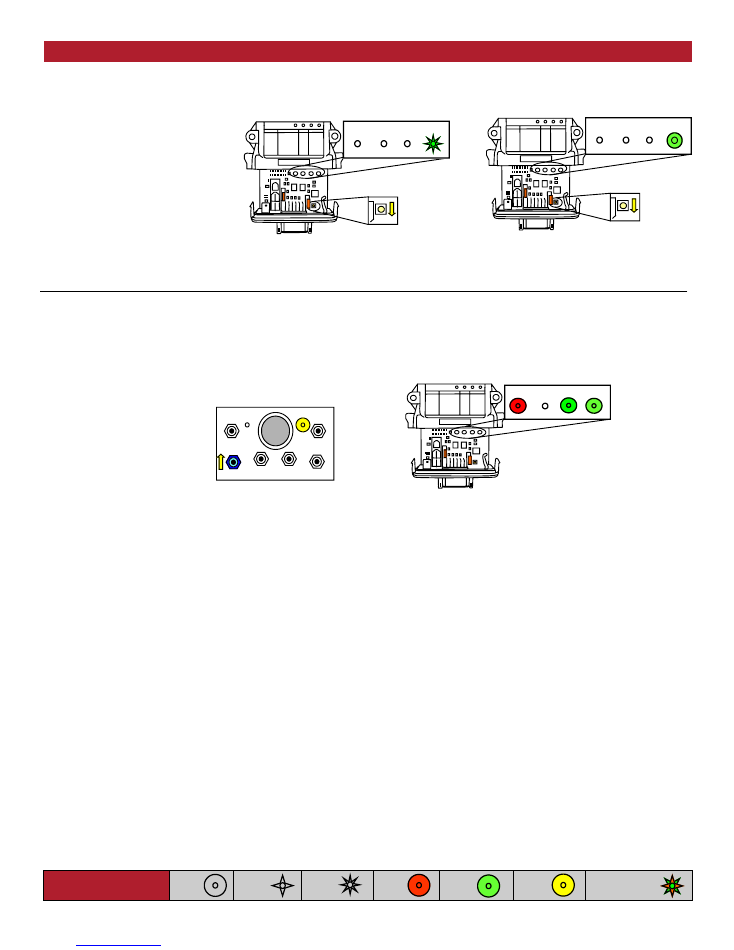
8
DMAN-xxxx-xx (Rev x.x)
www.omnexcontrols.com
call toll free: 1-800-663-8806
NOTE: If left idle in Setup Mode for over 30 seconds, the receiver will time out. The (Link) light and (Status) light will flash RED rap-
idly. To return to Setup Mode, repeat step 4.
A. Press & hold [Setup] button
until (Status) light goes from
slow flash to fast flash
B. Release [Setup] button.
(Status) light goes to solid
GREEN, (Link) light turns off
5. Download ID Code
4. Put R130 into Setup Mode
A. Press [SW-5] switch UP
B. (Link) light goes to GREEN.
Once complete, (Link) light
goes to RED as the trans-
mitter turns off
A.
B.
NOTE:
When replacing the receiver cover, ensure the cover snaps completely into place to create a weather proof seal around the base of the receiver.
B.
A.
Setup
Button
ESTOP FAULT LINK STATUS
Setup
Button
ESTOP FAULT LINK STATUS
ESTOP FAULT LINK STATUS
Download ID Code
(Use in case of Link Test failure)
Light Legend
Solid
Slow
Flash
Fast
Flash
Red
Light
Green
Light
Alternating Red
& Green Light
Yellow
Light
NOTE:
When downloading a new ID to a receiver, a safety feature requires that the transmitter be in close proximity to the receiver. This will pre-
vent a transmitter from accidentally reprogramming a different receiver in the area.
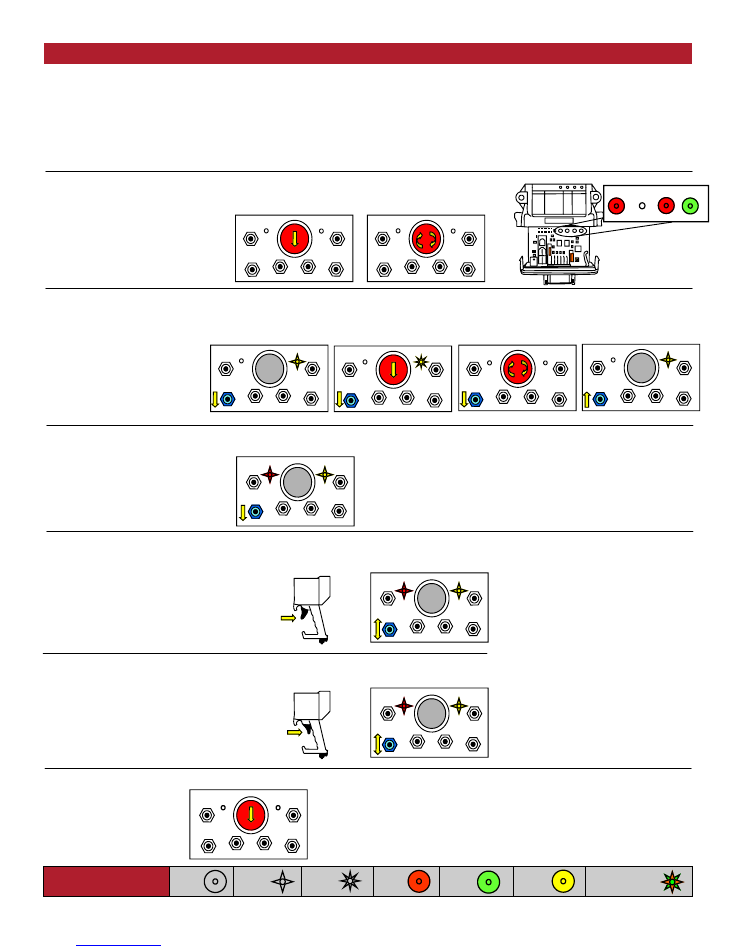
9
DMAN-xxxx-xx (Rev x.x)
www.omnexcontrols.com
call toll free: 1-800-663-8806
The transmitter’s trigger controls the receiver’s proportional output. The trigger is used in conjunction with any of the
transmitter’s switches. The proportional output can be activated when a switch is held UP or DOWN; it will become active
at an increasingly high level as the trigger is pulled. The minimum and maximum levels of the proportional output can be
calibrated by following these steps.
Refer to the
Light Legend
below for diagram details.
NOTE: Calibration settings can be reset to factory default in steps 4 & 5 by holding the [SW-5] switch UP or DOWN for 5 seconds
.
NOTE: All switches, except the
[SW-5] switch, remain active in
Calibration Mode.
A switch can be activated during
calibration to help determine the
desired levels.
A. Press [E-Stop]
B. Twist clockwise & Release
[E-Stop]
C. Supply power to the receiver
A. B.
1. Prepare T150, Power R130
A. Hold [SW-5] switch
DOWN
B. Press [E-Stop]
C. Twist clockwise & release
[E-Stop]
D. Release [SW-5] Switch
2. Power T150 into Configuration Mode
C.
B.
3. Setup T150
A. Press [SW-5] switch DOWN
A.
4. Set Minimum Level
A. Keep Trigger released to set mini-
mum level
B. Press [SW-5] switch UP to increase
minimum level or DOWN to
decrease it
A.
5. Set Maximum Level
A. Keep Trigger fully engaged to set
maximum level
B. Press [SW-5] switch UP to increase
maximum level or DOWN to
decrease it
A.
6. Power Off
A. Press [E-Stop]
A.
D.
A.
B.
B.
Calibrating Proportional Controls
Light Legend
Solid
Slow
Flash
Fast
Flash
Red
Light
Green
Light
Alternating Red
& Green Light
Yellow
Light
ESTOP FAULT LINK STATUS
C.
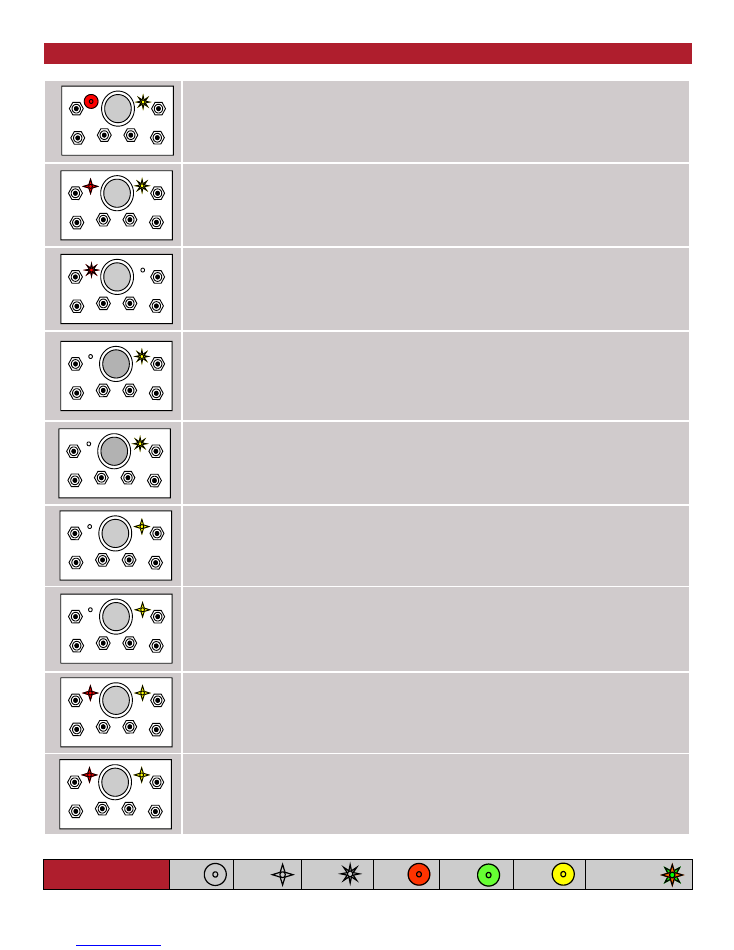
10
DMAN-xxxx-xx (Rev x.x)
www.omnexcontrols.com
call toll free: 1-800-663-8806
Tether connection detected
Low battery. Unit will run approximately 10 hours after Battery light starts flashing.
Flashing rapidly for 10 seconds indicates a transmitter failure.
Normal Operation
The Active light will flash several times per second, indicating that the transmitter is sending
signals to the receiver. The Active light will remain on momentarily whenever a function
changes
On Power Up
Release the E-Stop button within 10 seconds to power up the transmitter, or the unit will
power down.
Normal Operation
The transmitter is in Download Mode.
On Power Up
Press and release the E-Stop button within 10 seconds to power up the transmitter, or the
unit will power down.
Stuck switch detected. Ensure that all switches are in a centered position. The transmitter
will not power up when a function is ON.
On Power Down
Unit is still powered. Check for stuck switches, as the transmitter will not power down when a
function is ON. Alternating flash means that the transmitter is in Calibration Mode.
Diagnostics—T150 Transmitter
Light Legend
Solid
Slow
Flash
Fast
Flash
Red
Light
Green
Light
Alternating Red
& Green Light
Yellow
Light
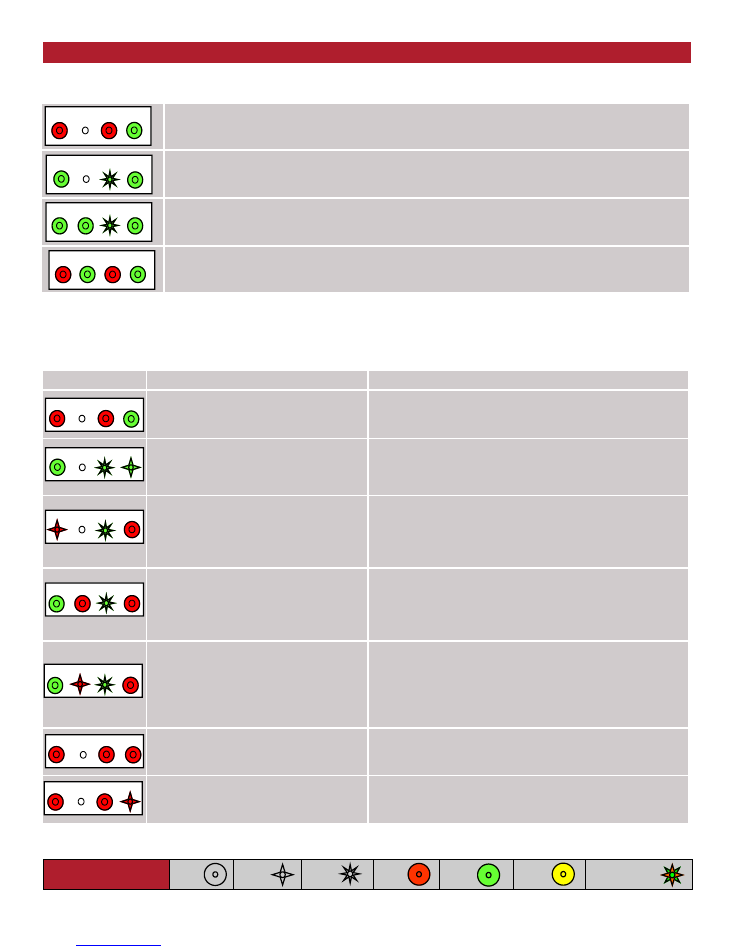
11
DMAN-xxxx-xx (Rev x.x)
www.omnexcontrols.com
call toll free: 1-800-663-8806
Light Legend
Solid
Slow
Flash
Fast
Flash
Red
Light
Green
Light
Alternating Red
& Green Light
Yellow
Light
Diagnostics - R130 Receiver
Normal Operation
Transmitter is OFF
If the transmitter is off, the receiver is operating properly.
Transmitter is ON
When the transmitter is turned on, the Link light (fast flashing) and E-Stop (GREEN) indicates the receiver
is operating properly.
Transmitter is in Operation
When a function is activated on the transmitter, the Fault light will turn on GREEN. This indicates the re-
ceiver is operating properly.
Transmitter is OFF
When a latched function is activated then the transmitter is turned off, the Fault light will stay on GREEN. If
the system was intentionally designed this way, the receiver is operating properly, if not call for service.
ESTOP FAULT LINK STATUS
ESTOP FAULT LINK STATUS
ESTOP FAULT LINK STATUS
Indicator Lights
Description
Solution
Transmitter is ON
The reason is the transmitter is not
communicating with the receiver.
Refer to
Troubleshooting Chart #3
for solutions.
Transmitter is ON
A low battery condition has been de-
tected.
To detect intermittent conditions caused by poor or cor-
roded ground or power circuits, the GREEN light will
continue to flash for 30 seconds after the condition has
been removed.
Transmitter is ON
An internal fault with the E-Stop has
been detected.
Inspect E-Stop wiring for short circuit. Disconnect E-Stop
wire as close to the receiver output as possible. If the
Status light changes to:
•
GREEN, a short occurs after disconnection point.
•
Stays flashing RED, send it in for service .
Transmitter is ON
A short to ground or excessive current
draw on an output. It is most likely
caused by a wiring fault.
Ensure transmitter is functioning properly, check status of
each output connection: Press each function button and
observe Fault Light.
•
If GREEN, everything is OK.
•
If RED, there is a short in that connection.
Transmitter is ON
3 possible causes:
•
E-Stop output connected to an output.
•
Wiring short to the battery.
•
2 output wires connected, indicator
comes on when a function is activated.
Follow the wire and check for connections with other
wires, disconnect to see if condition clears. If not, call
for service.
Refer to
Troubleshooting Chart #1
for solutions.
Transmitter is OFF
The receiver has detected an internal
fault.
Refer to
Troubleshooting Chart #1
for solutions.
Transmitter is OFF
Blown fuse detected.
Refer to
Page 7
for instructions on how to open the re-
ceiver case to access fuse. Check wiring for shorts or
bare spots. If fuses continue to blow, call for service.
Trouble Indicators
Note: In some cases, the indicator lights will be different depending on whether the transmitter is on or off. Please note the transmitter status in the
“Description” column for each case.
ESTOP
FAULT LINK STATUS
ESTOP
FAULT LINK STATUS
ESTOP
FAULT LINK STATUS
ESTOP
FAULT LINK STATUS
ESTOP
FAULT LINK STATUS
ESTOP
FAULT LINK STATUS
ESTOP
FAULT LINK STATUS
ESTOP FAULT LINK STATUS
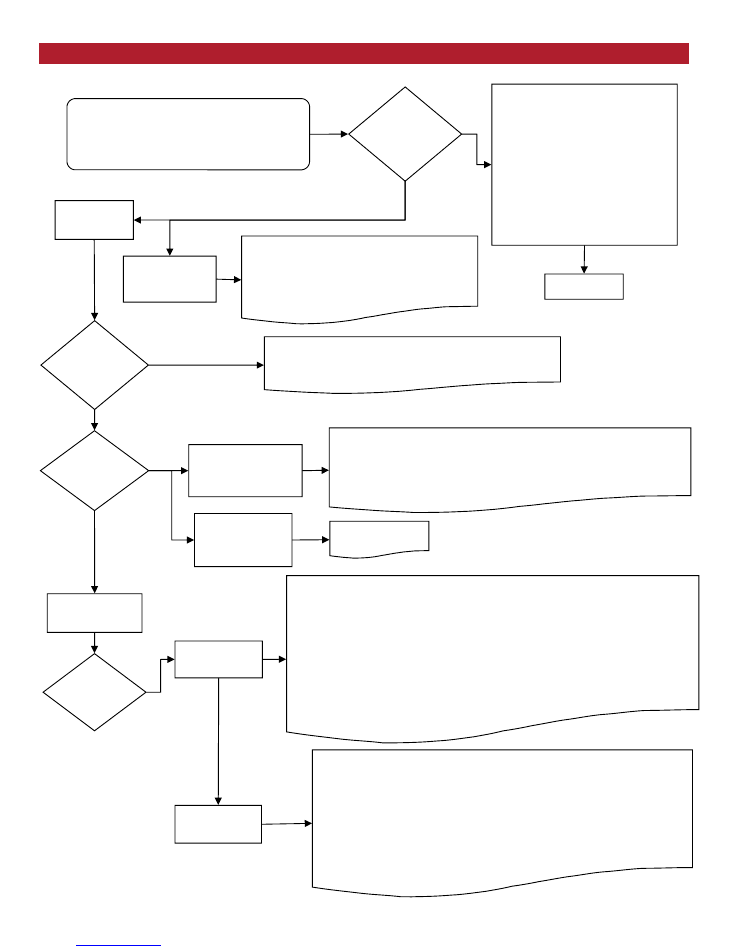
12
DMAN-xxxx-xx (Rev x.x)
www.omnexcontrols.com
call toll free: 1-800-663-8806
Start
Initial Condition:
Turn transmitter off (all lights are off—press the
OFF button)
Cycle power to receiver (turn off and back on)
What is the state
of the lights on
the receiver?
OK state:
Status—GREEN
Link—RED
E-Stop—RED
Fault—OFF
Note:
If there is a short to ground on
an output, it is not indicated at this
stage. To test for short to ground,
refer to the “*Fault Light is RED*”
procedure at the bottom of this page
and follow the instructions.
Problem state:
Status—RED
Go to
Chart 2
What is the
state of the E-
Stop light ?
OK state:
E-Stop—GREEN
Problem state:
E-Stop— Flashing
RED
Is the Status
light flashing
RED?
Fuse is blown, change fuse
1. Inspect wiring looking for short circuits (e.g. bare wires)
2. If problem re-occurs, call for service.
YES
NO
Inspect E-Stop wiring looking for short circuits (e.g. bare wires)
Disconnect the E-Stop output as close to the receiver output as possible.
If the status light changes to:
•
GREEN, there is a short is the wiring after the disconnection point.
•
Stays flashing RED, call for service .
What is the
state of the
Fault light ?
Problem state:
E-Stop is RED
Fault Light is OFF
Fault Light is
Flashing RED
*Fault Light is
RED*
Call for service.
3 possible causes:
A. There is a short to supply.
1. Disconnect A & B connectors from receiver and check all outputs for power (e.g.
bare wires, improper connections) make the correct adjustments
2. Call for service.
B. E-Stop wire connected to another output wire
1. Inspect wiring and look for improper connections
C.
2 output wires connected, indicator comes on when a function is pressed
1. Disconnect each output wire one at a time and press the function button,
if the light clears, that output is incorrectly connected. Continue for each
output until all output wires have been identified.
There is a short to ground.
Note:
This should only occur when the transmitter is on and a function but-
ton is pressed. In this case the Status light will be GREEN and will turn
RED at the same time as the Fault light.
Go to
Chart 2
to test the transmitter. If the transmitter is functioning prop-
erly, proceed to check the status of the output connections:
Press the function button and observe the Fault Light.
•
If the light turn GREEN, everything is OK.
•
If the Light turns RED, there is a short in that connection.
Problem state:
Status—flashing
GREEN
Low battery condition.
To detect intermittent
conditions caused by poor or corroded
ground or power circuits, the GREEN
light will continue to flash for 30 seconds
after the condition has been removed.
Troubleshooting Guide
Chart #1
Test the Receiver—R130
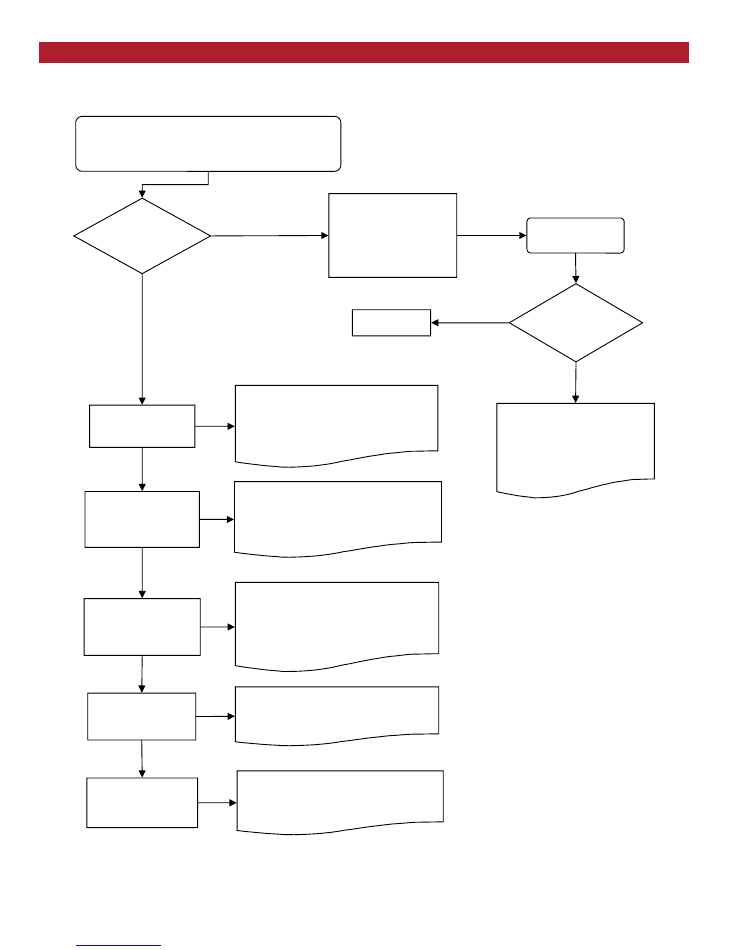
13
DMAN-xxxx-xx (Rev x.x)
www.omnexcontrols.com
call toll free: 1-800-663-8806
What is the state of
the lights?
Active light is flashing
rapidly and Battery
light flashing slowly
Low Battery—Change Batteries
Note: Low batteries will last approxi-
mately 10 hours once the Low Battery
light begins to flash.
Replace batteries by next shift.
Battery light and
Active light flash
alternately.
The transmitter is in Calibration mode
1. Turn unit OFF, then turn back ON
2. If condition persists, call for service.
Test the Transmitter—T150
Turn off the receiver
Ensure there are good batteries in the transmitter
Turn on the transmitter
OK state:
Active light—steady for
about 3 seconds then
goes to fast flash.
Battery light—OFF
E-Stop light—OFF
Go to
Chart 3
Activate a
function
Does the Active
light go to solid
YELLOW?
YES
Either the switch/trigger is
defective or the switch/trigger
connection to the circuit board
is broken.
Call for service
Complete the following steps in order:
1. Check battery orientation
2. Clean battery contacts
3. Check or Replace batteries
4. Call for service
Stuck switch:
1. Return all switches to neutral (OFF)
position
2. Toggle the switch a few times
3. Call for service
No light comes on
at any time
Both the Active light
and the Battery light
flash at the same time
NO
Press and release E-Stop if the condition
persists, then either there is a faulty E-
Stop or transmitter failure—call for ser-
vice
Battery light flashes
for 10 seconds then
all lights are OFF
Troubleshooting Guide (con’t)
Chart #2
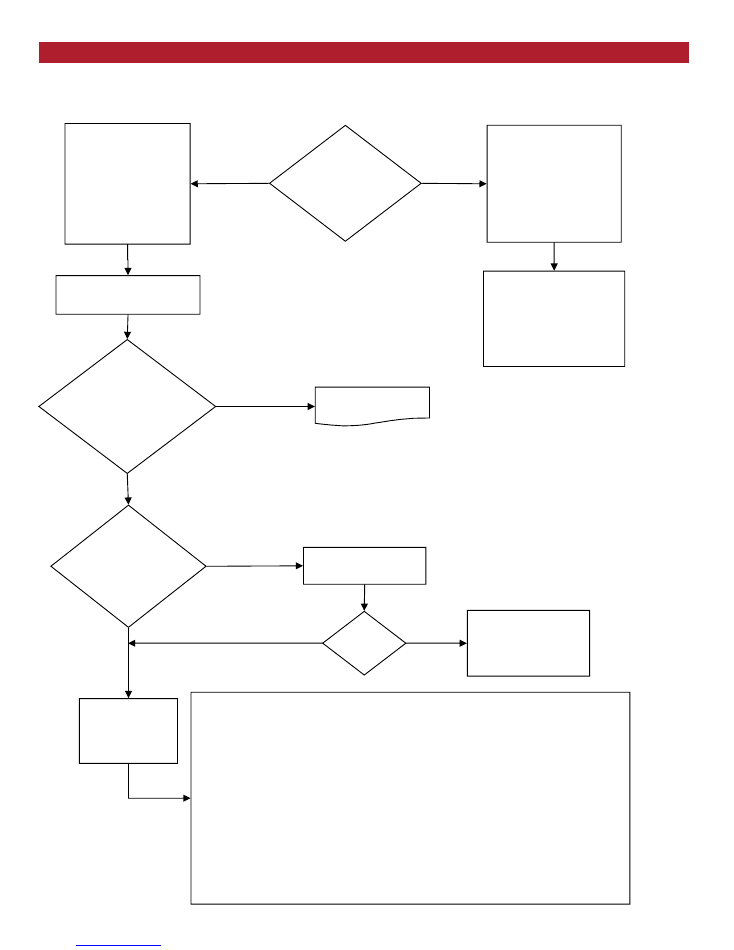
14
DMAN-xxxx-xx (Rev x.x)
www.omnexcontrols.com
call toll free: 1-800-663-8806
Testing the Transmitter / Receiver Communication
What is the status of
the lights of both the
transmitter and
receiver?
Transmitter:
Active light is flashing
Receiver:
Status—GREEN
Link—Flashing GREEN
Fault—OFF
E-Stop—GREEN
Transmitter:
Active light is flashing
Receiver:
Status—GREEN
Link—RED
Fault—OFF
E-Stop—RED
There is no link between the
transmitter and receiver
Do you have a
matched set? (i.e. the
transmitter and re-
ceiver should have
identical ID codes
YES
NO
Was the transmitter
accidentally swapped
with another one on
the job site?
Search the job site for
the correct transmitter.
POSSIBLY
Transmitter and receiver
should be working properly.
The problem may rest with
the machine instead of the
radio system
Call for service
Was it found?
Turn on the transmitter
to check if the units
function correctly. If
not, proceed to
Chart 1
NO
YES
The transmitter
code may need to
be re-downloaded
to the receiver
NO
!!Caution!!
Note:
Before you proceed with the Download ID procedure located on
Page 8,
great care
and caution must be adhered to. Also, refer to
Chart #4
for Tips and Considerations.
If by accident, the transmitters have been switched with another unit, by downloading the
ID code to a new receiver, it is possible for the transmitter to operate 2 units at the same
time (if the original receiver unit is still on the job site). Therefore it must be
certain that the transmitter / receiver pair are the correct set.
Secondly, once the download procedure is completed, ensure all other units on the job
site are stopped. Test the operation of the newly configured set to ensure no other
machines on the site work with the same transmitter.
Once you are certain that the transmitter / receiver pair are a unique set, continue
normal operations.
Call for service.
Troubleshooting Guide (con’t)
Chart #3

15
DMAN-xxxx-xx (Rev x.x)
www.omnexcontrols.com
call toll free: 1-800-663-8806
Troubleshooting Guide
Chart #4
Considerations when Downloading the ID
Potential downloading issues
If testing of the receiver and transmitter both show the system as working (Chart 1 & 2), then the transmitter and receiver
will both go into Download/Configuration mode.
Possible issues could arise during Step 4, the download phase of reprogramming. In this case there are 2 symptoms to
look for:
1. The Link light on the receiver will not turn GREEN when the power switch is toggled on the transmitter to download
2. The receiver will “time out” indicating that it didn’t receive a signal from the transmitter within the 30 seconds from
the time the receiver was put into Setup Mode.
If all indications appear normal during the download phase, test the link by turning on the transmitter (note: the transmit-
ter shuts off after transmitting the ID code in Step 4)
1. If the Link light on the receiver doesn’t turn GREEN, the receiver didn’t receive all of the information that was sent
from the transmitter.
Possible Solutions
1. Try the Downloading steps again
2. If this doesn’t correct the problem, send both the transmitter and receiver in for service.
Note: you could try to determine whether the fault lies with the transmitter or receiver by completing the downloading
procedure with a different transmitter. If this step works, then the fault lies with the original transmitter. If not, the
fault may lie with the receiver.
!!Caution!!
Note:
Before attempting downloading with another transmitter, understand that reprogramming the receiver with another
transmitter, could result in two receivers on the job site responding to the one transmitter. If the original transmitter was
sent in for repair,
Disconnect the receiver to continue using the machine without remote capability and without fear of inadvertently operat-
ing the machine with the other transmitter.
Reprogramming Tips:
1. Use a pointy instrument to depress the Setup button on the receiver (i.e. a pen) as the button is relatively small
2. Follow each step as laid out in the procedure
3. Never lay the receiver circuit board down on anything metallic (there are contact points on the back which could con-
tact the metal and damage the receiver)

16
DMAN-xxxx-xx (Rev x.x)
www.omnexcontrols.com
call toll free: 1-800-663-8806
Part
Part Number
Description
Batteries
B0010
4 x AA alkaline
R130 Output Cables
ACAB-2599-01
T150 Tether Cable (8 m. / 25 ft.) ACAB-2455-02 see illustration
Toggle Switch
AKIT-1504-04 Honeywell
1TL1-7
E-Stop Button
AKIT-1821-02
RAFIX16, 25mm, C&K 1.30074.2810300
See illustration
Magnet Back
AKIT-2498-02 see
illustration
Bipolar Diode Kit
AKIT-2492-01
36V, Bi-directional, Motorols P6KE36CA
Fuse
F0039 Bussman
ATC-15
Socket Connectors
J0418
Grey, 12-pin, Deutsch DTM06-12SA
J0419
Black, 12-pin, Deutsch DTM06-12SB
Wedge
J0420
12 pos., Deutsch WM12S
Pin
J0417
Female, Size 20, Deutsch 0462-201-20141
Sealing Plug
J0421
Size 20, Deutsch 0413-204-2005
R130 Connector Kit
AKIT-2337-01
Includes Deutsch socket connectors,
wedges, pins and sealing plugs.
Generic Output Cable- see illustration
Tether Cable
Magnet Back
R130 Output Cable
E-Stop
R130 Receiver
T150 Transmitter
Size
5.1” x 4.7” x 1.4”
(130mm x 119mm x 36mm)
7.9” x 4.2” x 4.1”
(200mm x 125mm x 105mm)
Weight
0.65lbs (0.295kg)
1.8lbs (0.817kg)
Construction
High impact plastic, weatherproof
High impact, low temperature plastic, weatherproof
Input Power
+9V to 30VDC
4AA alkaline batteries
Battery Life
N/A
>120 hours (continuous use)
Operating
Temperature Range
-40F to 158F (-40C to 70C)
-40F to 158F (-40C to 70C)
Outputs
3A (max) each (sourcing),
10A (max) each (combined)
N/A
Antenna
Internal
Internal
Approvals
USA
- FCC part 15.247
Canada
- ISC RSS 210 Issue 6, Sept.
Europe
- EN 440
Australia-
C-Tick
Parts & Accessories
FCC Rules and Compliance
This device complies with Part 15
of the FCC Rules. Operation is
subject to the following two condi-
tions: (1) This device may not
cause harmful interference, and
(2) this device must accept any
interference received, including
interference that may cause unde-
sired operation.
FCC
Part 15.247
ISC RSS 210 Issue 6, Sept.
2005
Specifications
Warranty
OMNEX Control Systems ULC warrants to the original purchaser that the OM-
NEX products are free from defects in materials and workmanship under normal
use and service for a period of ONE YEAR, parts (EXCLUDING: SWITCHES,
CRYSTALS, OR PARTS SUBJECT TO UNAUTHORIZED REPAIR OR MODIFI-
CATION) and labor from the date of delivery as evidenced by a copy of the
receipt. OMNEX's entire liability and your exclusive remedy shall be, at OM-
NEX's option, either the (a) repair or (b) replacement of the OMNEX product
which is returned within the warranty period to OMNEX freight collect by the
OMNEX APPROVED carrier with a copy of the purchase receipt and with the
return authorization of OMNEX. If failure has resulted from accident, abuse or
misapplication, OMNEX shall have no responsibility to repair or replace the
product under warranty. In no event shall OMNEX be responsible for incidental
or consequential damage caused by defects in its products, whether such dam-
age occurs or is discovered before or after replacement or repair and whether or
not such damage is caused by the negligence of OMNEX Control Systems ULC.
OMNEX Control Systems ULC
74-1833 Coast Meridian Road
Port Coquitlam, BC, Canada
V3C 6G5
Tel: 604-944-9247
Fax: 604-944-9267
Toll Free: 1-800-663-8806
www.omnexcontrols.com